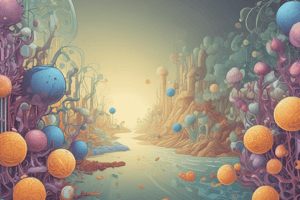Podcast
Questions and Answers
What is the result of bacteria spoiling wine?
What is the result of bacteria spoiling wine?
- Removing the flavor
- Increasing the shelf life
- Producing ethanol
- Turning it to vinegar (acetic acid) (correct)
Who developed the technique of pasteurization?
Who developed the technique of pasteurization?
- Louis Pasteur (correct)
- Joseph Lister
- Ferdinand Cohn
- Robert Koch
What was the contribution of Robert Koch?
What was the contribution of Robert Koch?
- Developing differential staining
- Introducing the concept of sterilization
- Developing pure culture techniques (correct)
- Discovering endospores
What is the purpose of Koch's Postulates?
What is the purpose of Koch's Postulates?
Who introduced the concept of aseptic technique?
Who introduced the concept of aseptic technique?
What is the characteristic of endospores?
What is the characteristic of endospores?
What is the purpose of Gram staining?
What is the purpose of Gram staining?
What is the shape of bacteria?
What is the shape of bacteria?
What is the main focus of microbiology?
What is the main focus of microbiology?
What is another term for microorganisms?
What is another term for microorganisms?
Who is credited with the discovery of microorganisms using a simple microscope?
Who is credited with the discovery of microorganisms using a simple microscope?
What was the prevailing theory opposed by Francesco Redi?
What was the prevailing theory opposed by Francesco Redi?
What is the alternative hypothesis to Spontaneous Generation?
What is the alternative hypothesis to Spontaneous Generation?
What did Louis Pasteur show that microbes are responsible for?
What did Louis Pasteur show that microbes are responsible for?
What is the process of converting sugar to alcohol to make beer and wine?
What is the process of converting sugar to alcohol to make beer and wine?
What is the purpose of aseptic techniques developed by Louis Pasteur?
What is the purpose of aseptic techniques developed by Louis Pasteur?
Flashcards are hidden until you start studying
Study Notes
What is Microbiology
- Study of organisms too small to be seen by the naked eye, requiring a microscope
- Microbes or microorganisms include bacteria, fungi, algae, protozoa, helminths, and prions
History of Microbiology
- Antonie van Leeuwenhoek first observed microbes using a simple microscope in 1673
- Francesco Redi opposed the prevailing theory of Spontaneous Generation in 1668, showing that maggots come from flies
Abiogenesis vs. Biogenesis
- Abiogenesis: living things can arise from vital forces present in nonliving and decaying matter
- Biogenesis: living organisms can arise only from preexisting life forms
The Golden Age of Microbiology
- Louis Pasteur:
- Showed microbes caused fermentation and spoilage
- Disproved spontaneous generation
- Developed aseptic techniques
- Developed a rabies vaccine
- Robert Koch:
- Developed solid growth media
- Developed pure culture techniques
- Developed simple stain technique
- Developed aseptic lab techniques
- Isolated bacteria as causative agents for anthrax, TB, and cholera
- Formulated Koch's Postulates
- Joseph Lister:
- Developed aseptic technique
- Introduced surgical site preparation with phenol
- Ferdinand Cohn:
- Discovered and described endospores
- Christian Gram:
- Developed differential staining of cell walls using various dyes (Gram positive and Gram negative)
Microbial Characteristics
- Bacteria occur in different shapes and sizes
- Bacteria shapes include rod-shaped, sphere-shaped, spiral-shaped, or filamentous-shaped
- Bacterial structure includes plasma membrane, cell wall, capsule, ribosomes, nucleoid, and cytoplasm (cytosol)
Studying That Suits You
Use AI to generate personalized quizzes and flashcards to suit your learning preferences.




